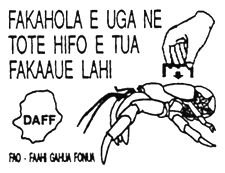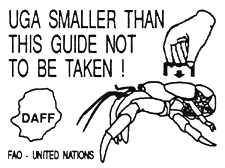Size Specifications

Graphic Designs for Upper Surface Logo
| A Niuean Text Version | B English Text Version |
 |  |

UGA (COCONUT CRAB) VIDEO OUTLINE
1. Introduction/Opening
2. Highlight World-wide Problem of Declining Numbers of Uga
3. Importance of Uga on Niue
Explain that uga were an historical source of protein for the Niuean people and that the crabs are now firmly enmeshed in Niuean culture
Show footage and comment on events at which uga are traditionally consumed by Niueans
General social events
Show interviews of Niueans responding to the question - How/Why are uga important on Niue?
Explain that conservation of uga does not mean not eating uga, it means ensuring uga are there to be eaten.
4. The Uga Over-exploitation Problem on Niue
Explain that uga are being over-exploited on Niue. Explain that over-exploitation means that crabs are being caught faster than they can reproduce and grow.
Indicate that in order to understand how and why uga are over-exploited on Niue it is necessary to understand something about how uga breed and grow:
Show footage of uga life cycle - Female uga on coast → females with large abdomens → females with immature orange eggs → females with mature eggs → females going down to coastal areas to release eggs → females releasing eggs into the ocean → larvae in ocean (footage unavailable) → larvae changing and entering a small mollusc shell (footage unavailable) → very small uga in shell leaves ocean and crawls onto shore → crab grows and finally discards mollusc shell and looks like a small uga. At the end show footage of the uga life-cycle diagram from the poster with appropriate explanation (narration combined with pointing to each event). Explain that uga do not start producing eggs until about 5 or 6 years old and that although uga may produce up to 300 000 eggs at one time at best only 1 or 2 will survive to grow into uga (show footage of uga with eggs and releasing eggs as this is explained).
{Final edit footage of the Uga life cycle will be provided by C. Schiller from footage obtained from Vanuatu and Christmas Island and edited in Brisbane. Footage will also be accompanied by a commentary outlining the various stages of the life cycle, as well as highlighting those aspects of the cycle that make uga extremely susceptible to over-harvesting.}
Explain how uga grow. ie. After the abdomen of the uga has become very large (show footage of uga with large abdomen) the crab digs a hole in the ground and sheds its old shell or ‘skin’ and forms a new one, growing as it does sothis process requires approximately 1–3 months and occurs during the period June to September. Adult uga grow only once a year but small uga may grow 2 or 3 times a year.
Explain that uga grow very slowly - A 750 gram crab (show footage of such a crab) being approximately 15 years old
Explain that the previously described uga life cycle and slow growth rate combine together to make uga susceptible to over-harvesting. ie. so few eggs survive and uga grow so slowly that uga taken by hunters can not be quickly replaced by uga produced from eggs-hunting is quick but replacement is very slow.
Pose the question - Given that the number of people on Niue is declining, why/how are uga being over-hunted?
Present the theory that the uga problem has not suddenly occurred - rather it is primarily the result of exporting crabs to Niueans resident in New Zealand. Indicate that current research indicates that the uga began to be over-exploited soon after the airport opened and export of uga by air to New Zealand was possible. Present the idea that export, together with Niuean hunting practices, are responsible for uga over-exploitation (show footage of airport and uga being checked in at the airport as this is being explained).
Describe traditional Niuean hunting methods and describe any changes to these methods that have occurred over time. Show footage of Niueans using traditional materials and methods to hunt uga, from setting of baits to conducting the hunt.
Outline those Niuean hunting practices which are not allowing the uga population to grow and explain the problems associated with each:
The use of dogs to hunt crabs. As a result dogs are now a natural predator of uga and often hunt in packs. Show footage of dogs being used in an uga hunt.
Stress that if the uga are to survive in large numbers on Niue it is important that small uga not be hunted so that they can grow large enough to produce eggs. At the same time it is essential that uga with eggs be left alone so that they may release their eggs into the ocean. Show footage of hunters with burning torches collecting females with eggs as they move along the shore cliffs.
Destruction of suitable uga habitat. Uga need particular types of bush/forest and ground to live. They cannot live in dry thin bush or fernland areas. Niuean gardens destroy the forest habitat required by the uga. Point out that it is not expected that people no longer clear bush to make gardens, rather that more efficient use be made of gardens in order to reduce the necessity to destroy forest. Uga prefer living close to the coast and do not occur in large numbers more than 2 km from the ocean. It is therefore most important to try and preserve forests that lie within 2 km of the coast. Show footage of bulldozers clearing forest, show footage of forest and then of garden to highlight the before and after effect.
Introduction of uga predators. The common practice of keeping pigs in bush pens has resulted in many pigs escaping and becoming feral. Such feral pigs will eat uga and, like the dogs, have become a natural predator of the crab. The impact of pig predation on uga is unknown but would none the less contribute to the reduction in numbers of uga on Niue.
Present a summary of the factors that have resulted in the over-exploitation of the uga on Niue (showing appropriate footage where possible)- Over-exploitation of the uga on Niue has resulted from a combination of over-hunting; bad hunting methods; uncontrolled export; destruction of uga habitat; introduction of uga predators and no self-imposed conservation measures. Strongly state that if people continue to hunt and export uga as they do now then in a few years the number of uga on Niue will become very low and they will get harder and harder to catch. Stress that there is a solution - Conservation (show an appropriate mix of footage).
5. Solution to the Uga Problem - Conservation
Indicate that by conservation we do not mean that no uga can be caught, rather that hunting ideas and methods need to be slightly changed to protect certain sizes and types of uga at certain times of the year.
Outline, and briefly explain, proposed measures to protect/conserve the uga: (show footage of text outlining the 4 conservation measures).
Minimum size restrictions. Show footage of an appropriately sized uga sitting next to the plastic size-guide. Show how the size of the uga is measured using the guide (ie. one end of the guide is put in the crack at the join of the ‘head’ and ‘body’ and the guide should be shorter than the back, or thorax, of the crab.)
Protection of uga with large orange abdomens during the period October to March.
Protection of crabs carrying eggs - this include uga as they move down to the sea to release their eggs.
Reduction/Control of uga exports.
Possible closure of some areas to hunters during the period October to March.
Show interviews of the Minister for Agriculture and the Director of Agriculture, Forests and Fisheries explaining in more detail the proposed conservation measures.
Indicate that the determination of appropriate size restrictions, hunting seasons and hunting area restrictions requires detailed information on the uga on Niue. Because the uga had not been previously studied on Niue the necessary information was not available. As a result the Niue government requested assistance from the United Nations/FAO in obtaining information on Niue ugas.
6. The FAO/SPADP Uga Research Project on Niue
Explain that the study began in 1988 with a 1 month pilot survey which found that numbers and average size of uga on Niue were in decline and recommended that a further detailed study be conducted.
An 8 month follow-up study commenced in May 1990 conducted by an FAO consultant together a staff member (Colin Etuata) from the Niue Department of Agriculture, Forestry and Fisheries.
Show footage with narration of the major components of the study:
Cutting of transects (paths) through the bush; measuring the distance travelled using a Hip Chain (trails a cotton thread behind you as you walk through the bush and measures the amount of cotton used); marking of permanent baiting areas (10 per transect, one every 40 metres meters) using bright plastic markers.
Colin putting out baits (1/2 a coconut fruit tied to a tree or rock) along a transect during the day and then revisiting the transect at night to conduct a survey. Show Colin as he conducts a survey- walking along the transect searching for uga in the bush and at the baits, especially show him checking the baits.
Colin finding an uga at a bait and then him measuring (using calipers), weighing (using spring balance) and marking (using felt pen and scribe) that uga and then releasing it. Also show him recording the information in his notebook
Explain that the data collected during the study was used to determine the number of uga on Niue, where most of them live and their average size. This information was then be used to determine the minimum recommended hunting size and will be used to determine further measures necessary to conserve the uga.
7. Conclusion
Present a summary of the matters presented in the video
Reiterate the problem facing the uga on Niue
Summarise the measures proposed to conserve the uga.
Emphasise the point that conservation measures must be imposed not to prevent Niueans from enjoying uga, but to ensure that uga are present on Niue, for Niueans to enjoy, for generations to come.
